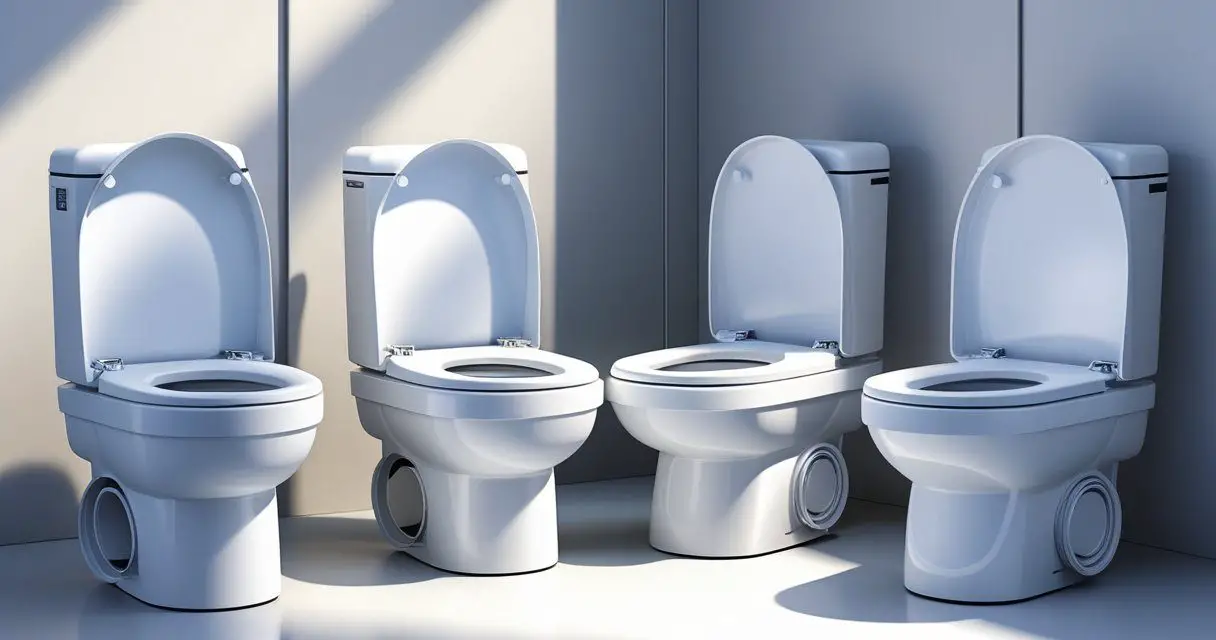Would you like to save this article?
You’re sitting in your RV, nature is calling, and suddenly you realize – choosing the wrong toilet system could make or break your entire adventure. Whether you’re a weekend warrior or a full-time nomad, your toilet choice affects everything from your water supply to your sanity. One experienced RVer tested four different toilet systems so you don’t have to learn the hard way about midnight mishaps and smelly surprises.
The truth is, your waste doesn’t just magically disappear when you’re living on the road. You’re literally driving around with it, and how you handle it determines whether you’ll love or hate your RV lifestyle. From simple bucket systems to high-tech composting units, each option has its own quirks that could either save your trip or ruin your rug.
1. The Luggable Loo: Simple but Smelly
The Luggable Loo is basically a five-gallon bucket with delusions of grandeur. This simple system consists of a bucket with a snap-down lid and optional bags with gel agents. It costs around $25-40 and works great for short camping trips, but living with it full-time is a different story.
Your biggest challenge? The dreaded pee-and-poo cocktail that creates an ungodly smell. When liquids and solids mix together, especially in a moving vehicle, you’ll quickly discover why separation is key. Many users end up needing a separate container for liquid waste to avoid turning their RV into a mobile stink bomb.
| Pros | Cons |
|---|---|
| Extremely affordable ($25-40) | Mixing waste creates strong odors |
| Lightweight and portable | Bags with gel can be expensive |
| Works for 3-day camping trips | Not practical for full-time use |
| Simple to understand and use | Night-time accidents are common |
Fun fact: The average RV toilet uses 16 ounces of water per flush for liquids and up to 1 gallon for solids, according to The RVgeeks. The Luggable Loo uses zero water, which sounds great until you’re chasing it down the road in a windstorm.
Here’s what you didn’t expect: Using this system at 2 AM when you’re half-asleep is like playing Russian roulette with your carpet. You’ll quickly learn that depth perception and coordination aren’t your strong suits when nature calls in the middle of the night.
2. Cassette Toilets: Europe’s Favorite for a Reason
Cassette toilets are like the sophisticated European cousin of RV toilets. Popular across Europe but less common in North America, these systems use a removable 5-gallon waste tank that you can dump in various locations. They cost between $200-500 and offer more dumping flexibility than traditional black tanks.
The game-changer? You can dump the cassette in rest areas, porta-potties, or even regular toilets. This gives you way more options than waiting for RV dump stations. However, you’ll be emptying it every 2-3 days, and yes, you’ll be getting up close and personal with your waste.
| Feature | Details |
|---|---|
| Tank Capacity | 5 gallons (typical) |
| Dumping Frequency | Every 2-3 days for 2 people |
| Water Usage | Moderate (less than traditional RV toilet) |
| Dump Locations | Rest areas, porta-potties, toilets, dump stations |
| Weight | Portable but heavy when full |
Statistics show that traditional RV toilets are used in 90% of North American RVs, making cassette toilets the road less traveled, according to The Fit RV. But in Europe, they’re everywhere because they actually make sense for smaller rigs.
You’ll discover that chemicals aren’t optional – they’re mandatory. Even if you think you can get away without them (just pee, right?), the smell will quickly convince you otherwise. The tank becomes a small, anaerobic environment where waste breaks down differently than in larger black tanks.
3. Traditional RV Toilet with Black Tank: The Heavy Hitter
The traditional RV toilet is what most people expect – familiar, comfortable, and deceptively complicated. It looks like a home toilet minus the back tank, uses a foot pedal for flushing, and sends everything to a hidden black tank. Tank capacities range from 15-50 gallons, with 18 gallons being common in smaller RVs.
Here’s the reality check: you’re hauling around the equivalent of another person in waste water. An 18-gallon black tank weighs about 150 pounds when full (water weighs 8.34 pounds per gallon), significantly affecting your fuel costs and handling.
The water consumption is staggering when you’re boondocking. Using up to 1 gallon per flush for solids means your fresh water disappears fast. The average RV uses 10-15 gallons of water per day per person, and toilet flushing can account for 20-30% of that usage.
| Tank Size | Days for 2 People | Weight When Full | Estimated Flushes |
|---|---|---|---|
| 15 gallons | 7-10 days | 125 lbs | 45-60 |
| 25 gallons | 12-16 days | 208 lbs | 75-100 |
| 40 gallons | 18-25 days | 333 lbs | 120-160 |
You didn’t sign up for the “poo pyramid” problem. When you don’t use enough water, solids can build up into a pyramid shape that blocks your tank sensors and creates clogs. RV parks regularly see people who need professional pump-outs because of this issue.
The freezing factor is real. Both your flush water lines and your black tank contents can freeze in winter, potentially leaving you with a very expensive and smelly problem. This makes traditional toilets challenging for winter camping without proper heating.
4. Composting Toilets: The Game Changer
Composting toilets separate liquids and solids, use zero water, and actually work better than you’d expect. The composting toilet market is exploding, growing from $1.5 billion in 2024 to an expected $3.2 billion by 2033 – a 9% annual growth rate driven largely by RV adoption, according to Verified Market Reports.
The Trelino Evo M breaks the mold at just 9.5 pounds and $475. It has a 1.3-gallon liquid tank (emptied every 2 days) and a 2.1-gallon solids container (emptied weekly to monthly). Unlike complex electric composting toilets, this one keeps it simple.
The separation system is brilliant. Liquids go into one container with a special membrane that closes after use to prevent splashing and odors. Solids drop into a separate bucket where you layer them with composting medium like coconut coir, hemp, or wood pellets.
| Component | Capacity | Frequency | Disposal Method |
|---|---|---|---|
| Liquid Tank | 1.3 gallons | Every 2 days | Rest areas, toilets, trees |
| Solids Container | 2.1 gallons | 1-4 weeks | Garbage (in compostable bags) |
| Composting Medium | Variable | As needed | Available at Walmart, nurseries |
The environmental benefits are substantial. Composting toilets eliminate the need for 1.7 billion gallons of wastewater processed daily by traditional sewage systems, according to the EPA. They use zero water and create no chemical runoff.
You’ll be shocked at how little it smells. When liquids and solids are separated properly, there’s virtually no odor – sometimes just a slight earthy smell from the composting medium. The key is proper layering and keeping everything separated.
The learning curve includes some awkward conversations. Guys must sit to pee (standing defeats the separation system), and you’ll need to explain the system to guests. But after six weeks of testing, most users find the benefits far outweigh the adjustments.
The Verdict: What Actually Works
For weekend warriors: The Luggable Loo works fine for 2-3 day trips if you use separate containers for liquids and solids.
For frequent travelers: Cassette toilets offer the best balance of convenience and flexibility, especially if you’re comfortable with more frequent dumping.
For traditional RVers: Black tank systems work well if you have reliable access to dump stations and don’t mind the weight and water usage.
For boondockers and full-timers: Composting toilets are revolutionary for off-grid camping, water conservation, and environmental responsibility.
The composting toilet market’s rapid growth reflects a fundamental shift toward sustainable RVing. With RVs and camper vans representing the fastest-growing segment in composting toilet adoption, more manufacturers are creating user-friendly options that don’t require electrical hookups or complex maintenance.
SOURCES
- I Tried 4 RV Toilets So You Don’t Have To! – YouTube
- How Much Water Does An RV Toilet Use Per Flush? – The RVgeeks
- Comparing RV Toilet Systems: Traditional, Cassette, and Compost – The Fit RV
- Composting Toilet Market Size, Share, Industry SWOT & Forecast – Verified Market Reports
- Simple Guide to RV Holding Tanks – RVezy
- Everything You Need to Know About RV Toilets and Black Tanks – Roadtrippers
- Water Efficiency Technology Fact Sheet Composting Toilets – EPA






